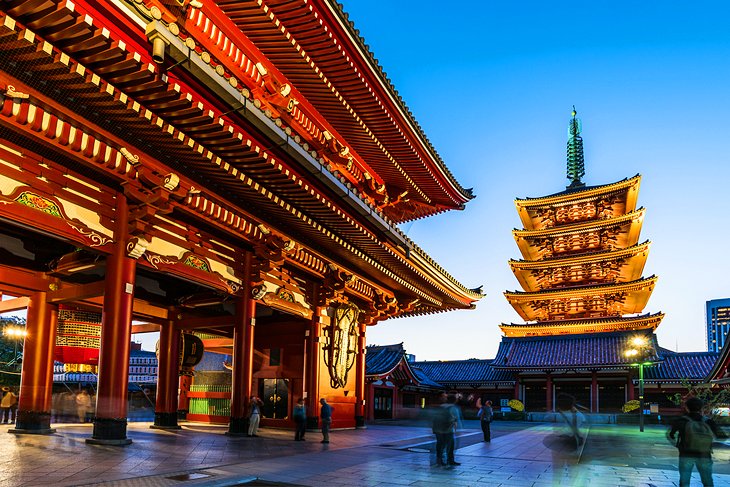In a city full of temples, Sensōji is the oldest, boasting almost one and a half millennia of history. It features Tokyo’s biggest souvenir market, as well as perhaps the gaudiest rendezvous point—its Kaminarimon Gate with the huge red chochin lantern. Sensōji Temple in Asakusa is just a 15-minute train ride from Tokyo Station (20 from Shinjuku, 30 from Shibuya or just 5 from Akihabara)—here’s what to know and how to explore the place.
There are many ways to visit Sensōji and appreciate the temple and its surrounds, but the standard is to start from the Kaminarimon Gate and move up. The two statues guarding it are of the two rather obscure deities Fujin-sama and Raijin-sama, “god of wind” and “god of thunder and lightning” respectively. The latter (i.e. the left one) has given his name to the gate since another reading of “rai” is “kaminari”. Incidentally, this is what the characters on the big red lantern say: “Kaminarimon” or “thundergate”. When passing through the gate, check under the base of the lantern—you’ll find a dragon hiding there! This is because the official name of Sensōji Temple is “Kinryuzan” or “Golden Dragon Mountain”; the same thing is written on the green plate above the lantern.
The street lined with shops (mostly souvenir but also regular shops, some of them over 100 years old) is Nakamise Dori, meaning “inside street”, i.e. inside the temple grounds. They might seem like a recent invention to help relieve you of your tourist dollars, but actually the Nakamise goes way back: you can find it in pilgrim guides from the times of Edo. Apparently, 18th—century Edoites were as entrepreneurial as 21st—century Tokyoites and 18th—century pilgrims were as consumeristic as we are today!
Having passed the Hozomon Gate, you’ve reached Sensōji proper, the main temple (Hondo or Kannon-do) still houses the statue of Kannon the fishermen found 1400 years ago (or so they say: the statue was allegedly so radiant that they buried it in the ground inside Sensōji Temple and no one has actually seen it since). The shops at both sides of the last stretch sell the official Sensōji merchandise: omamori amulets, scrolls, incense to burn at the huge burner in front of the temple’s stairs, books about the temple, (in Japanese) and omikuji fortunes. If you aren’t set on some particular souvenir, something from there will be cheaper and more worthy as a conversation piece. Personally I’d go for the goshuin calligraphy with the temple’s red stamp and the date of your visit: it goes for US$3.72 * and it’s written just for you by the temple’s priests.
Hondo’s (the main temple) visiting hours are 6am to 5am and it’s really worth going up the stairs and wandering around. If you do, don’t neglect to look up: some of the greatest artworks from Sensōji’s collection are painted directly on the ceiling or are hanging on the upper part of the walls. The room where the services take place is also open and you can watch, but usually you aren’t allowed inside. If you want to try though, the entrance is on the right side and there’s always a guard to provide you with information.
